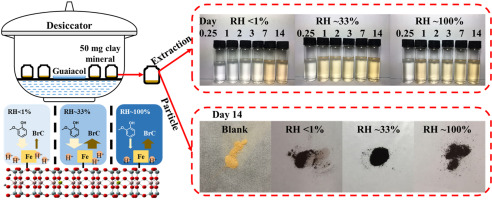当前位置:
X-MOL 学术
›
Atmos. Environ.
›
论文详情
Our official English website, www.x-mol.net, welcomes your feedback! (Note: you will need to create a separate account there.)
Formation of brown carbon on Fe-bearing clay from volatile phenol under simulated atmospheric conditions
Atmospheric Environment ( IF 5 ) Pub Date : 2020-05-01 , DOI: 10.1016/j.atmosenv.2020.117427 Jingyi Ling , Feng Sheng , Yi Wang , Anping Peng , Xin Jin , Cheng Gu
Atmospheric Environment ( IF 5 ) Pub Date : 2020-05-01 , DOI: 10.1016/j.atmosenv.2020.117427 Jingyi Ling , Feng Sheng , Yi Wang , Anping Peng , Xin Jin , Cheng Gu

|
Abstract Atmospheric brown carbon (BrC) has recently attracted great concerns due to its potential contribution to climate change. It was reported that dissolved Fe(III) species can act as an efficient oxidant to catalyze the polymerization of volatile phenol substances, subsequently forming atmospheric BrC in aerosols. Since Fe in the atmosphere is commonly associated with clay mineral dusts, the transformation of phenol substances on Fe-bearing clay mineral surface is potentially important for BrC formation. In this study, taking guaiacol as the model phenol substance, its brown carbon formation process was investigated on Fe(III) modified montmorillonite under different relative humidities (RHs). The spectroscopic features and compositions of the produced BrC were systematically characterized. The results demonstrated that the interface FeOH2+ is the key species to promote the polymerization of guaiacol, and RH plays a significant role to influence the surface acidity of clay and the gas-to-particle adsorption of guaiacol. The BrC was produced with the most abundance and variety under moderate RH (~33%), while higher RH (~100%) accelerated the polymerization rate. Since aerosol moisture content might not largely influence the hydroxylation states of the surface bearing Fe(III) species, it signifies the importance of clay associated Fe(III) to catalyze the BrC formation in varied conditions Our study highlights the importance of clay mineral dust on the formation of BrC, and reveals the brown carbon formation pathways under environmentally relevant conditions.
中文翻译:

模拟大气条件下挥发性酚在含铁粘土上形成褐碳
摘要 大气棕碳(BrC)由于其对气候变化的潜在贡献,最近引起了极大的关注。据报道,溶解的 Fe(III) 物质可以作为一种有效的氧化剂来催化挥发性酚类物质的聚合,随后在气溶胶中形成大气 BrC。由于大气中的铁通常与粘土矿物粉尘有关,含铁粘土矿物表面的酚类物质的转化对于 BrC 的形成可能很重要。本研究以愈创木酚为模型酚类物质,研究了不同相对湿度(RHs)下Fe(III)改性蒙脱石的褐碳形成过程。系统地表征了产生的 BrC 的光谱特征和组成。结果表明界面FeOH2+是促进愈创木酚聚合的关键物质,RH对粘土的表面酸度和愈创木酚的气体对颗粒的吸附有显着影响。BrC 在中等 RH (~33%) 下产生的丰度和种类最多,而较高的 RH (~100%) 加速了聚合速率。由于气溶胶水分含量可能不会在很大程度上影响带有 Fe(III) 物质的表面的羟基化状态,这表明粘土相关 Fe(III) 在不同条件下催化 BrC 形成的重要性我们的研究强调了粘土矿物粉尘对BrC 的形成,并揭示了环境相关条件下棕色碳的形成途径。RH对粘土的表面酸度和愈创木酚的气体-颗粒吸附有重要影响。在中等 RH (~33%) 下,BrC 产生的丰度和种类最多,而较高的 RH (~100%) 加速了聚合速率。由于气溶胶水分含量可能不会在很大程度上影响带有 Fe(III) 物质的表面的羟基化状态,这表明粘土相关 Fe(III) 在不同条件下催化 BrC 形成的重要性我们的研究强调了粘土矿物粉尘对BrC 的形成,并揭示了环境相关条件下棕色碳的形成途径。RH对粘土的表面酸度和愈创木酚的气体-颗粒吸附有重要影响。在中等 RH (~33%) 下,BrC 产生的丰度和种类最多,而较高的 RH (~100%) 加速了聚合速率。由于气溶胶水分含量可能不会在很大程度上影响带有 Fe(III) 物质的表面的羟基化状态,这表明粘土相关 Fe(III) 在不同条件下催化 BrC 形成的重要性我们的研究强调了粘土矿物粉尘对BrC 的形成,并揭示了环境相关条件下棕色碳的形成途径。而较高的 RH (~100%) 会加速聚合速率。由于气溶胶水分含量可能不会在很大程度上影响带有 Fe(III) 物质的表面的羟基化状态,这表明粘土相关 Fe(III) 在不同条件下催化 BrC 形成的重要性我们的研究强调了粘土矿物粉尘对BrC 的形成,并揭示了环境相关条件下棕色碳的形成途径。而较高的 RH (~100%) 会加速聚合速率。由于气溶胶水分含量可能不会在很大程度上影响带有 Fe(III) 物质的表面的羟基化状态,这表明粘土相关 Fe(III) 在不同条件下催化 BrC 形成的重要性我们的研究强调了粘土矿物粉尘对BrC 的形成,并揭示了环境相关条件下棕色碳的形成途径。
更新日期:2020-05-01
中文翻译:

模拟大气条件下挥发性酚在含铁粘土上形成褐碳
摘要 大气棕碳(BrC)由于其对气候变化的潜在贡献,最近引起了极大的关注。据报道,溶解的 Fe(III) 物质可以作为一种有效的氧化剂来催化挥发性酚类物质的聚合,随后在气溶胶中形成大气 BrC。由于大气中的铁通常与粘土矿物粉尘有关,含铁粘土矿物表面的酚类物质的转化对于 BrC 的形成可能很重要。本研究以愈创木酚为模型酚类物质,研究了不同相对湿度(RHs)下Fe(III)改性蒙脱石的褐碳形成过程。系统地表征了产生的 BrC 的光谱特征和组成。结果表明界面FeOH2+是促进愈创木酚聚合的关键物质,RH对粘土的表面酸度和愈创木酚的气体对颗粒的吸附有显着影响。BrC 在中等 RH (~33%) 下产生的丰度和种类最多,而较高的 RH (~100%) 加速了聚合速率。由于气溶胶水分含量可能不会在很大程度上影响带有 Fe(III) 物质的表面的羟基化状态,这表明粘土相关 Fe(III) 在不同条件下催化 BrC 形成的重要性我们的研究强调了粘土矿物粉尘对BrC 的形成,并揭示了环境相关条件下棕色碳的形成途径。RH对粘土的表面酸度和愈创木酚的气体-颗粒吸附有重要影响。在中等 RH (~33%) 下,BrC 产生的丰度和种类最多,而较高的 RH (~100%) 加速了聚合速率。由于气溶胶水分含量可能不会在很大程度上影响带有 Fe(III) 物质的表面的羟基化状态,这表明粘土相关 Fe(III) 在不同条件下催化 BrC 形成的重要性我们的研究强调了粘土矿物粉尘对BrC 的形成,并揭示了环境相关条件下棕色碳的形成途径。RH对粘土的表面酸度和愈创木酚的气体-颗粒吸附有重要影响。在中等 RH (~33%) 下,BrC 产生的丰度和种类最多,而较高的 RH (~100%) 加速了聚合速率。由于气溶胶水分含量可能不会在很大程度上影响带有 Fe(III) 物质的表面的羟基化状态,这表明粘土相关 Fe(III) 在不同条件下催化 BrC 形成的重要性我们的研究强调了粘土矿物粉尘对BrC 的形成,并揭示了环境相关条件下棕色碳的形成途径。而较高的 RH (~100%) 会加速聚合速率。由于气溶胶水分含量可能不会在很大程度上影响带有 Fe(III) 物质的表面的羟基化状态,这表明粘土相关 Fe(III) 在不同条件下催化 BrC 形成的重要性我们的研究强调了粘土矿物粉尘对BrC 的形成,并揭示了环境相关条件下棕色碳的形成途径。而较高的 RH (~100%) 会加速聚合速率。由于气溶胶水分含量可能不会在很大程度上影响带有 Fe(III) 物质的表面的羟基化状态,这表明粘土相关 Fe(III) 在不同条件下催化 BrC 形成的重要性我们的研究强调了粘土矿物粉尘对BrC 的形成,并揭示了环境相关条件下棕色碳的形成途径。


























 京公网安备 11010802027423号
京公网安备 11010802027423号